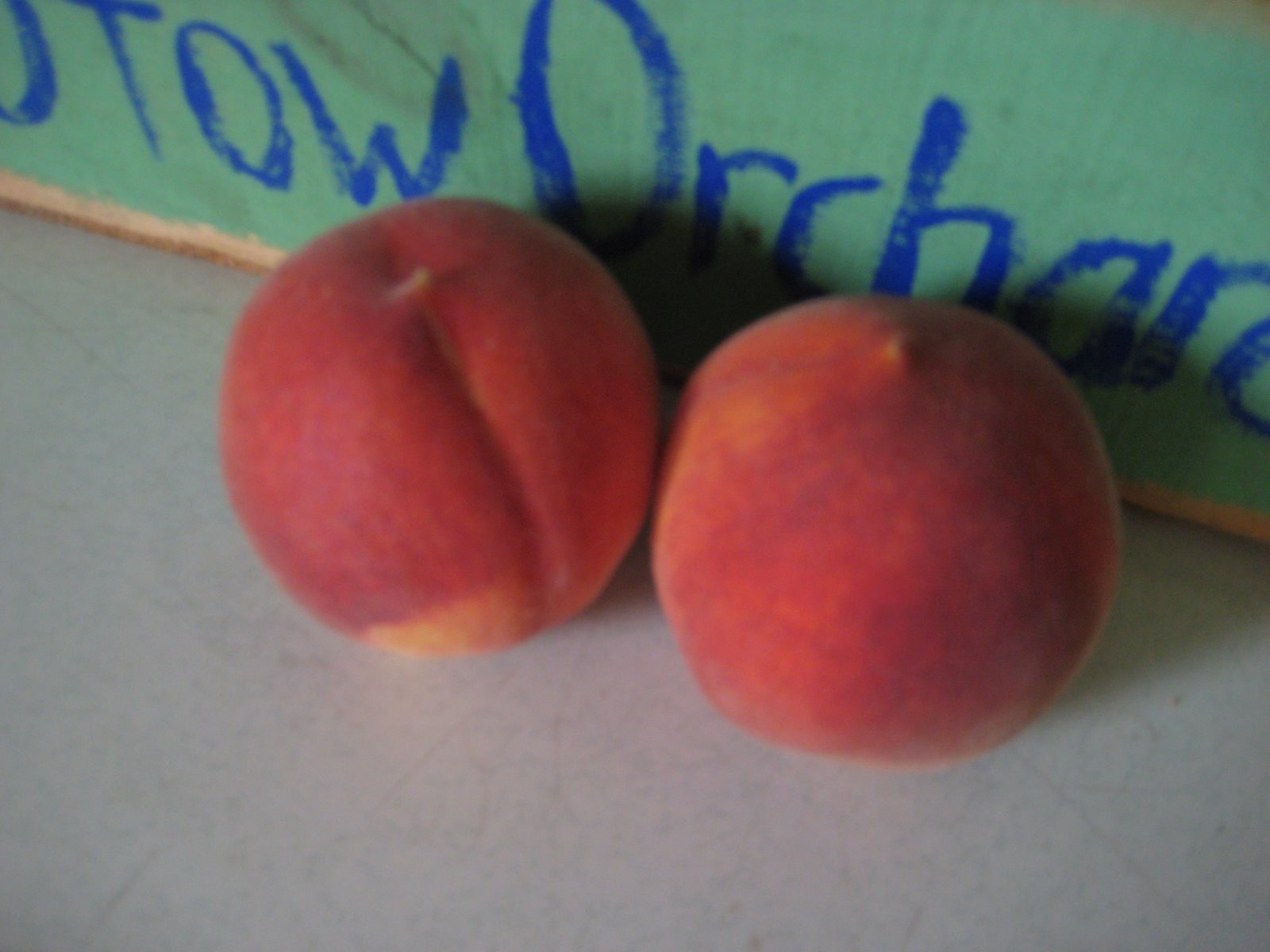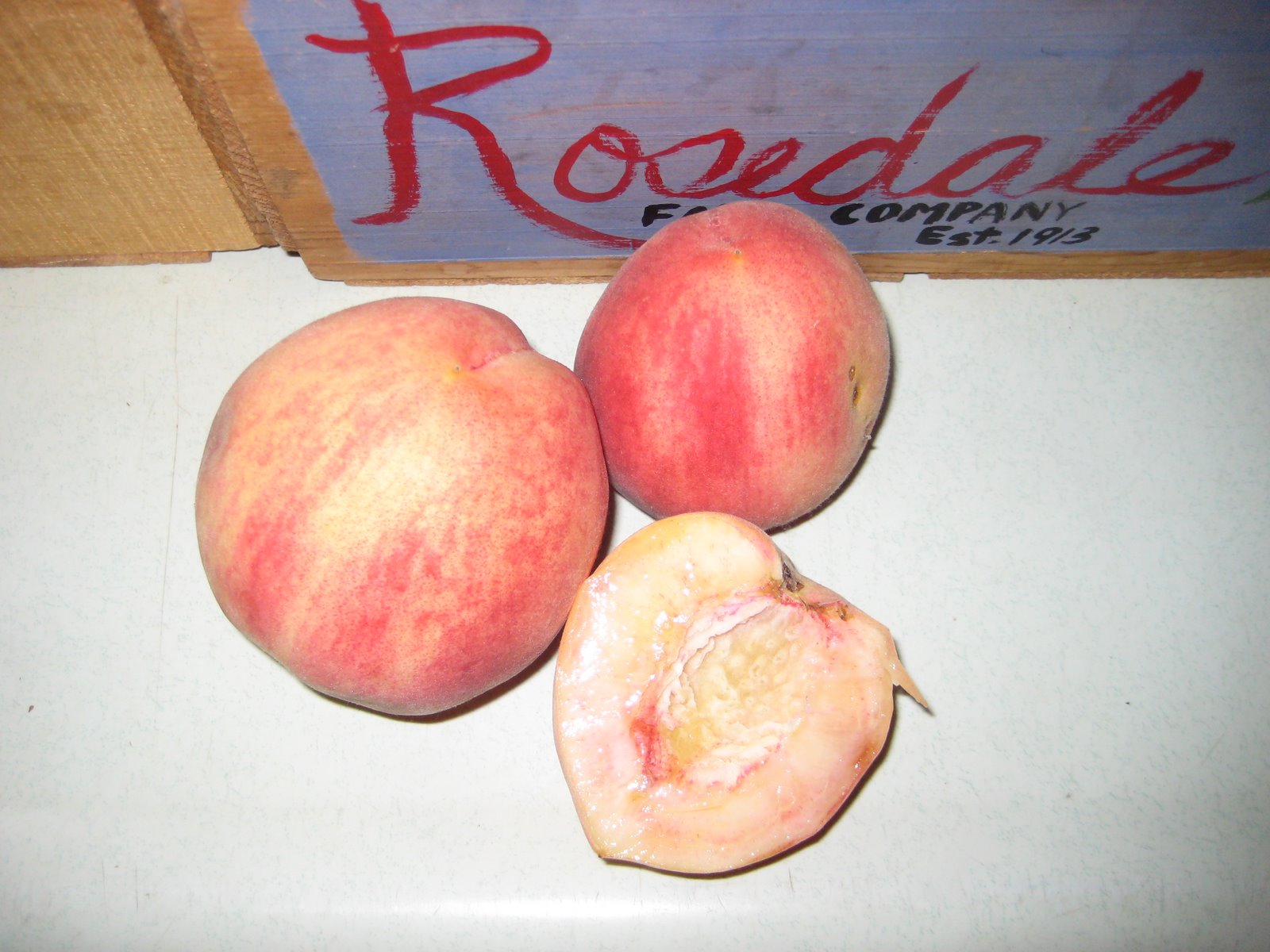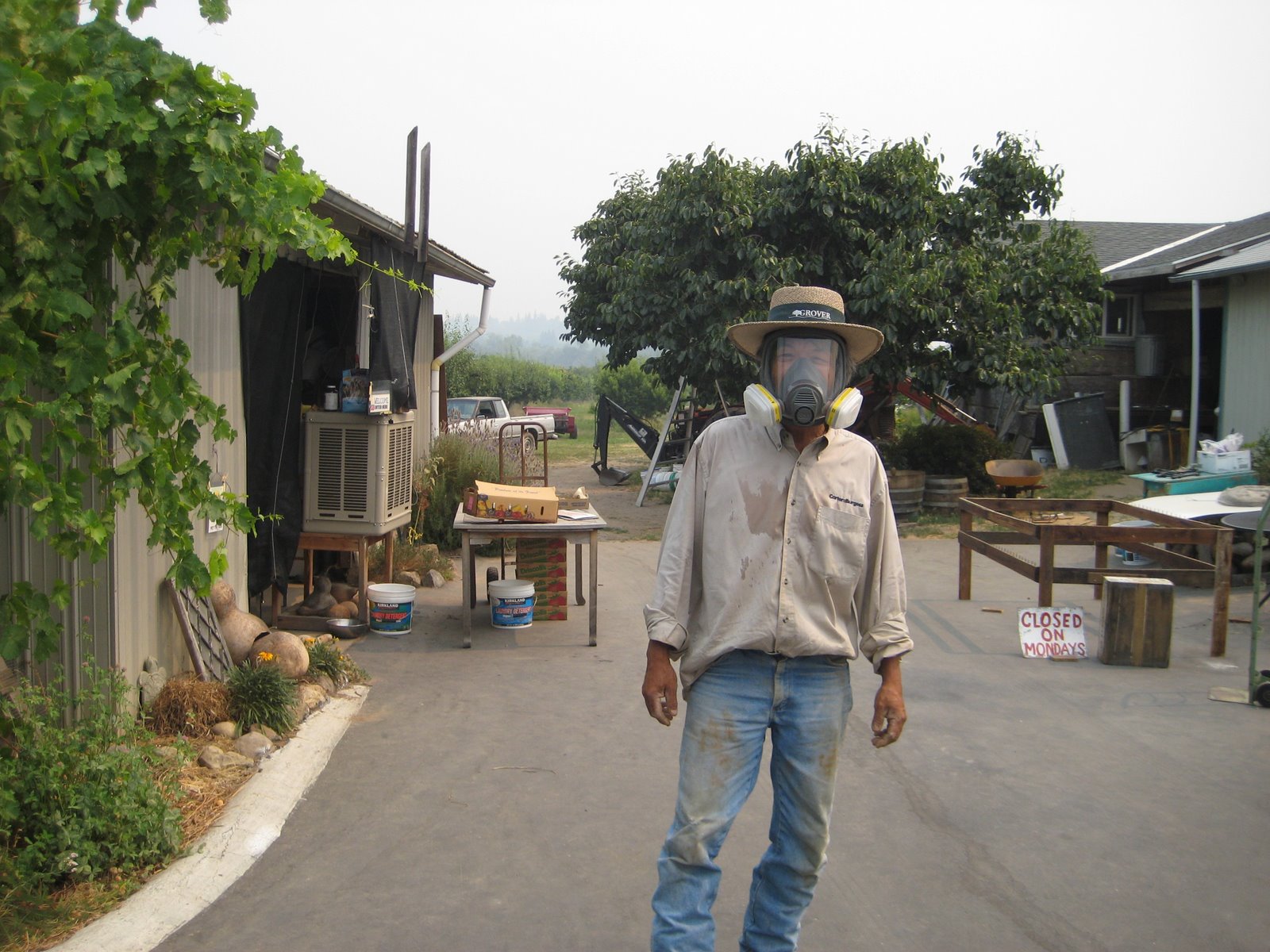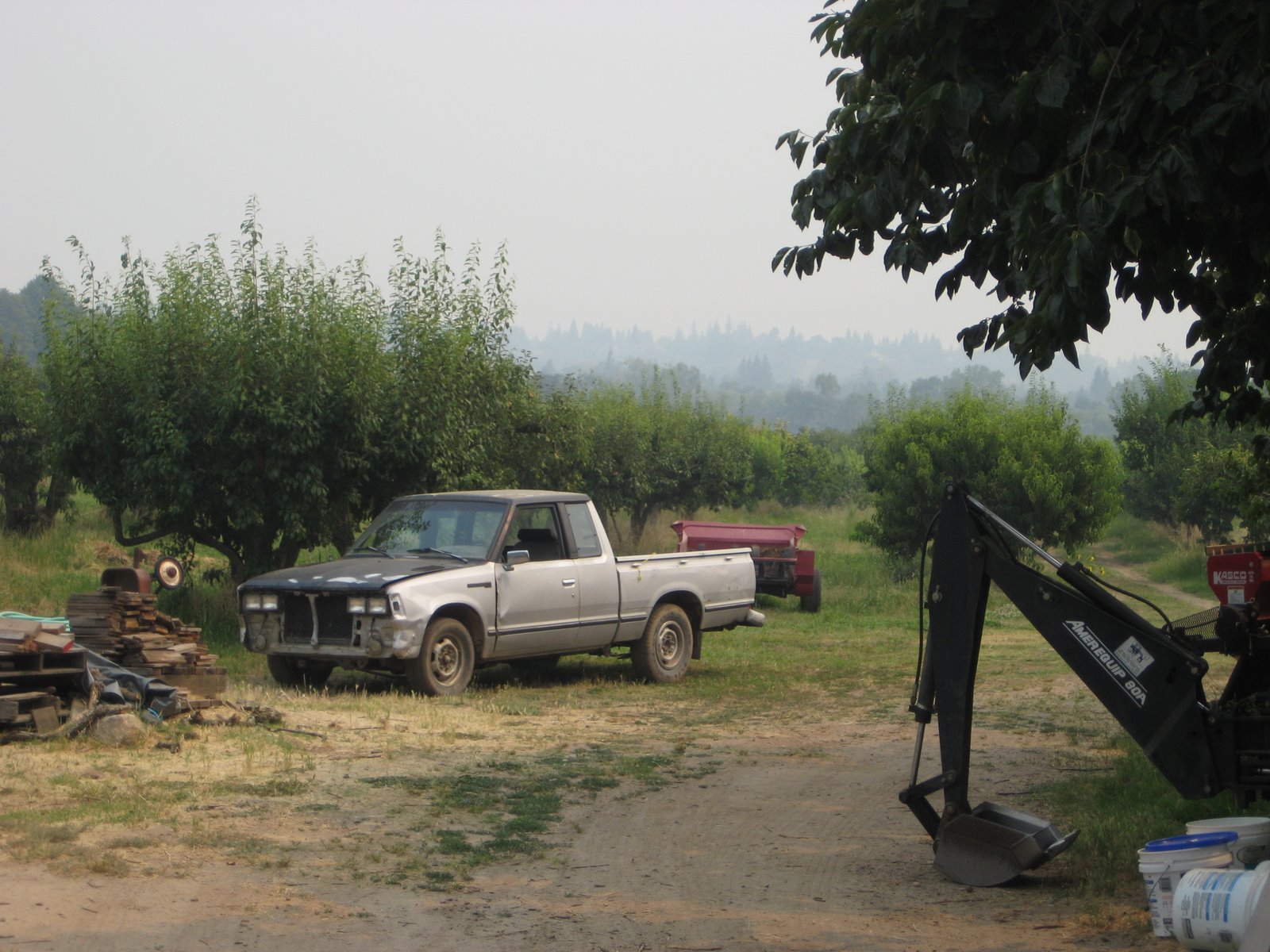
The fruit stand will be closed on New Year's Day and the day after, (Jan. 1st and 2nd). We'll open again on Saturday, Jan. 3rd.
Above is a photo of Viviano next to the mochi-pounding mortar at the orchard.
Monday, December 29, 2008
Happy New Year
Sunday, December 28, 2008
What's at the Fruit Stand
- Fresh Persimmons--Hachiya (soft and hard), gyombo (soft), Fuyu, Maru and vodka-treated Hyakume
- Kiwi--picked for the first time this week
- Apples--Koyama's Granny Smith
- Mandarins--satsuma (only a small supply left)
- Quince--the last of the season
- Vegetables--Jerusalem artichoke
- Gourds--for decorations and crafting
- Honey--from bees at our orchard
Above is a photo of kiwi fruit growing on vines at the orchard.
Hoshigaki Update

Hoshigaki (dried persimmon) is not available for sale at the fruit stand for now. We need to fill our previous mail orders and wait for the last persimmons to finish drying. At the very end of the season hoshigaki take longer to finish, and the quality is not always as good. The last persimmons peeled for drying were ripest and more likely to develop tears when drying and massaging. The weather to dry the last persimmons is less sunny and more damp and cold than Fall weather, also, so this makes drying take longer.
We expect that we'll have hoshigaki to pick up for sale in the fruit stand again in mid-January, but we may not have premium quality. If you would like to be added to a waiting list and notified when the last of this season's hoshigaki is available at the fruit stand, please call or email us. Our email is otoworchard@yahoo.com, and our phone number is (916) 791-7165.
At left is a photo of a box of hoshigaki strings and stems, snapped off from the persimmons when they're nearly finished drying. We carefully take the stems out of the loops and wash the strings to use them again for next season.
Friday, December 19, 2008
An End to New Hoshigaki Orders

Thank you for all your interest and orders our massaged dried persimmons (hoshigaki). We now have to stop accepting any new mail orders for Hoshigaki for this season. If you have already sent in an order, we do expect to be able to fill it, but we are unable to take any more new orders.
We hope to be finished sending out all the mail orders we've already received by mid-January. If you've sent in your order recently, you probably already know that orders sent to us after Dec. 4th are unlikely to arrive at their destinations by Christmas. Please email us with any questions about your order (otoworchard@yahoo.com).
Our small family orchard has only a few workers and hoshigaki really is a "Slow Food". Now with the colder and more damp weather, the persimmons now hanging on the racks are likely to take 8 weeks to complete the drying process, as compared to a minimum of 4 weeks as in October. It's not possible to speed up the process and still have nice, soft hoshigaki. We appreciate your patience.
We still have small amounts for of hoshigaki (hand-dried persimmons) for sale at the fruit stand if you're able to come to our orchard and pick it up, but we don't have enough left to take any new mail orders. It's helpful to call ahead to the fruit stand if you plan to come pick up hoshigaki so that we can have it reserved for you. Our phone number is (916) 791-1656.
In September of 2009 we'll start taking orders for next year. If you want to order next year, we recommend that you get your order in as early as possible, because we fill the earliest ones first.
The above photo is a close up of hoshigaki (massaged dried persimmon). You can see the natural sugar that comes out on the surface.
Wednesday, December 17, 2008
What's at the Fruit Stand

At the fruit stand you'll find:
- Hoshigaki (massaged dried persimmons)--various grades for sale at a range of prices per pound
- Fresh Persimmons--Hachiya (soft and hard), gyombo (soft), Fuyu, Maru and vodka-treated Hyakume
- Apples--Koyama's Granny Smith
- Mandarins--satsuma
- Quince--the last of the season
- Vegetables--Chiles (fish), Swiss chard, Jerusalem artichoke
- Gourds--for decorations and crafting
- Honey--from our orchard
Above is a photo of satsuma mandarins.
Sunday, December 14, 2008
Lots of Jerusalem Artichokes

A few weekends ago I started digging up my garden's Jerusalem artichoke bed. It was amazing how many each plant produced. The wheel barrow in the photo at left shows what came from just two plants.
This is the first time I've tried to grow Jerusalem artichoke. I was suprised that growing it was so easy and required such little work. I remember weeding the bed just once in the Spring, and then I just watered it regularly. Each piece of tuber I planted produced a plant around 6 feet tall. The plants are in the sunflower family (they're also called sunchokes), and in the late summer they blossomed and had small yellow sunflowers. I snipped off their blossoms so that more energy could go to the roots to help them produce the Jerusalem artichoke tubers. The plants are now mostly dead and brown, so I dug up a couple of plants to harvest the tubers.
Jerusalem artichokes are native to eastern North America and are said to have been introduced to Samuel de Champlain by Native Americans in Massachusettes. Mostly they are cooked like potatoes or other root vegetables. Another interesting thing about Jerusalem artichokes is that they contain inulin, a type of starch that is considered healthier for diabetics. This weekend I hope to finish digging up the Jerusalem artichoke bed and have some ready to sell at the fruit stand.
Click here to go to about.com 's web page about Jerusalem artichoke, where you can also find links to recipes.
Thursday, December 4, 2008
Cold Weather Ripens Persimmons

This past week's colder weather and fog has brought an end to peeling fresh persimmons to dry for hoshigaki. The hachiya and gyombo persimmons on the trees have all started to get too ripe and soft to be suitable for peeling. Therefore, what we already have peeled and begun to dry is all the hoshigaki that will be able to be produced for this year's season. The persimmons we recently started drying will probably take longer to dry than those we started in the warmer weather in October (8 weeks in comparison to 4 weeks).
The ripening of the persimmons also means that we must stop mailing out orders of fresh persimmons. The fruit is now too soft to ship and have arrive in good condition. We are still selling fresh persimmons at the fruit stand, but we can't take any new mail orders for fresh persimmons. Our mail order items are now limited to hoshigaki (dried persimmons) and mandarins.
Since the airing of the PBS California Gold television program featuring the orchard we have been swamped with mail orders for hoshigaki. Although it was great as publicity for hoshigaki and the orchard, it's been hard to keep up with the increase in orders.
We are sorry to say that if you order hoshigaki (dried persimmons) now, we can't guarantee that your order will be shipped out in time to arrive before Christmas.
We hope that customers who are able will come to the orchard and buy hoshigaki at the fruit stand. If you know you'll be coming to pick up hoshigaki, it's helpful if you call ahead and tell us. You can reach us at (916) 791-1656.
What's at the Fruit Stand:
- Hoshigaki (dried persimmons)--various grades for sale at a range of prices per pound
- Fresh Persimmons--Hachiya (soft and hard), Fuyu, Maru and vodka-treated Hyakume
- Apples--Koyama's Granny Smith
- Mandarins--Nodahara's satsuma
- Quince
- Pomegranate--Red
- Pecans
- Vegetables--Peppers (hot and sweet), Swiss chard, Jerusalem artichoke
- Gourds--for decorations and crafting
Tuesday, November 25, 2008
Hoshigaki Mail Order and What's at the Fruit Stand

We now have lots of hoshigaki (massage-dried persimmons) for sale at the orchard's fruit stand and available for sale through mail order. If you want to make an mail order for hoshigaki or fresh fruit, please print out our order form (under the hoshigaki/persimmons tab), fill it out, and mail it to us with your check. We're still taking mail orders, but since we are very busy it may take up to a few weeks for you to receive your order.
What's at the Fruit Stand:
- Hoshigaki (dried persimmons)--various grades for sale at a range of prices per pound
- Fresh Persimmons--Hachiya (soft and hard), Fuyu, Maru and vodka-treated Hyakume
- Apples--Koyama's Granny Smith
- Mandarins--Nodahara's satsuma
- Quince
- Pomegranate--Red
- Walnuts & Pecans
- Vegetables--Peppers (hot and sweet), Swiss Chard, basil
- Gourds--for decorations and crafting
In the photo above is Toshio showing some visiting Boy Scouts how to hang a peeled persimmon for drying.
See the orchard on PBS's "California Heartland"
At left is a photo of kids playing in the hay maze.
Wednesday, November 19, 2008
What's New at the Orchard
Mail Orders--
We have started mailing out some hoshigaki orders and fresh persimmon orders. We are still taking orders for hoshigaki (massage-dried persimmons), fresh hachiya, fuyu, and mandarins. Unfortunately we have run out of maru and vodka-treated hyakume for mail orders. If you are able to come to the fruit stand you can still buy maru and hyakume, but we don't have enough left to fill any new mail orders.
What's in the Fruit Stand Now:
- Persimmons--Hachiya (firm and soft), fuyu, maru, vodka-treated hyakume, hoshigaki (massage-dried)
- Pomegranates--red variety
- Quince
- Walnuts and Pecans ( in the shell)
- Olives--cured
- Gourds---lots of different kinds for decorating and for making crafts
- Vegetables--Zucchini, Swiss Chard, Basil
As you can see, we no longer have tomatoes listed. If you come to the fruit stand we may have a few left, but almost all of them have cracks and blemishes. The same is true for zucchini, what's left is not at its best. It's time to pull out the old plants and get the gardens ready for next season soon.
The Mountain Manderin Festival happens this weekend near us in Auburn, CA. Our manderins are not yet ready, but other area growers will have theirs at the festival. It takes place at Gold country Fairgrounds in Auburn, from Nov. 21st-23rd. The festival's website is www.mountainmanderinfestival.com.
Above is a photo of a gyombo persimmon, another variety we use for making hoshigaki.
Thursday, November 6, 2008
Hoshigaki is now at the Fruitstand


We are happy to say that we now have hoshigaki (dried persimmons) at the fruit stand for sale. If you were planning to pick up hoshigaki at our fruit stand, the first of this year's hoshigaki has finished. Please call ahead if you are able, and we'll have your order ready. Our phone number is (916) 791-1656. We hope to start sending out mail orders within the next two weeks.
There are a lot of soft hachiya persimmons at the fruit stand, all ready using for baking or for eating fresh. We still have hard hachiyas too, if you'd like to ripen them at home.
Here's what's at the fruitstand now:
- Persimmons--Hachiya, Maru, Hyakume (vodka-treated), and Hoshigaki (dried)
- Asian Pear--Okusankichi (seconds)
- Pomegranates--white and red varieties
- Quince
- Walnuts--in the shell
- Olives--cured
- Vegetables--zucchini, hot chiles, garlic, Swiss chard and basil
- Pumpkins
- Gourds--lots of different kinds for decorating and crafting
Sunday, October 26, 2008
Persimons, Pumpkins & Gourds


We are very busy making hoshigaki and working with it in all its stages. We're still peeling and hanging new persimmons, massaging them, and moving them from room to room, according to what environment the stage they're in requires. The weather is still good for peeling and hanging new hachiya persimmons, although it has been hotter than usual for this point in the year. We've even had to block some of the drying persimmons from the sun during the hottest parts of the day.
Some of the first persimmons that were peeled at the end of September are getting sugar and are nearly at their finished state. We expect that within two weeks we'll have the first supply of hoshigaki to sell at the fruit stand and to send out in mail orders. We welcome people to visit the orchard to see how we make hoshigaki, but we only have small amounts we can sell until more of this year's hoshigaki is finished.
There is still time to visit our pumpkin patch. You can take a wagon or cart through the orchard and bring pumpkins back to the fruit stand to check out. Kids can also play on the hay bale maze. We have small colorful gourds for fall decorations and large gourds for crafting, too.
What can you find in the Fruit Stand?
- Persimmons--Hachiya, Maru, Hyakume (vodka-treated), and small quantities of Hoshigaki (dried)
- Asian Pear--Okusankichi
- Apples-- Golden Delicious, Granny Smith
- Pomegranates--white and red varieties
- Quince
- Jujube
- Vegetables--zucchini, tomatoes, tomatillos, chiles (both sweet and hot), garlic, Swiss chard and basil
- Pumpkins--in the fruit stand and in our pumpkin patch
- Gourds--lots of different kinds for decorating and crafting
Thursday, October 16, 2008
What's in the Fruitstand
 In the fruit stand we now have:
In the fruit stand we now have:
- Persimmons--Hachiya, Maru, Hyakume (vodka-treated), and small quantities of Hoshigaki (dried)
- Asian Pear--Okusankichi
- European Pear--Comice
- Apples--Fuji, Mutsu, Golden Delicious, Granny Smith
- Pomegranates--white and red varieties
- Plums--Casselman
- Quince
- Jujube
- Vegetables--winter squash, zucchini, tomatoes, tomatillos, chiles (both sweet and hot), garlic, onions, potatoes, Swiss chard and basil
- Pumpkins--in the fruit stand and in our pumpkin patch
Above is a photo of a pomegranate flower in the spring.
Tuesday, October 14, 2008
What is a jujube?

This weekend we learned more about jujubes when we went to Twin Peaks Orchards in Newcastle to demonstrate making hoshigaki as part of the PlacerGrown's yearly Farm and Barn Tour. We have a few jujube trees at the orchard and sell jujubes in the fruit stand, but we haven't felt like we know very much about them. Customers at the fruit stand sometimes say that they remember having jujubes dried in tea, or that they remember them from childhood and are so surprised to see them again. People often ask what they taste like, but it's hard to describe because it's something like a dry apple or pear with other flavors mixed in.
Twin Peaks Orchards grows a lot of jujube (amongst other fruit) and has a flyer out with more information about them. According to their flyer, jujubes are also called "red dates" or "Chinese dates" and are a small tree in the buckthorn family. "The immature fruit is smooth-green, and resembles the consistency and taste of an apple, but as it matures more, it darkens to red to purplish-black and becomes wrinkled, looking like a small date (hence the name Chinese Date)." Jujube contains many vitamins, including a high concentration of vitamin C, and are "one of the world's oldest fruits, used in Chinese medicine for over 4000 years."
At left is a photo of a jujube growing at our orchard.
Monday, October 13, 2008
Ordering Hoshigaki
We'll post an announcement here on the web site when this year's hoshigaki (dried persimmon) is available. If you plan to order some it is best to get your order in as soon as possible, as we are never sure how much the weather will allow us to make.
Call us if you would like to pick up an order at the fruit stand. If you would like hoshigaki or other fruit mailed to you, please print out the order form from our website and mail it to us with a check. We have samples of last year's hoshigaki in the fruit stand, but this year's hoshigaki isn't yet finished.
Monday, October 6, 2008
Persimmon Season Begins
We have started peeling and hanging hachiya persimmons to dry for hoshigaki. Come to the fruit stand if you can, and see the beginning of the process. We also have some fresh hachiya, maru (chocolate) persimmons and hyakume persimmons in the fruit stand. We treat the hyakume with a bit of vodka to remove its natural astringency. The vodka is undetectable to the taste, but the hyakume is left sweet and delicious, even when still firm.
This week, Otow Orchard will be featured on television on the PBS show, California Gold with Huell Howser. Last fall he and his show's staff came to interview us about making hoshigaki (dried persimmons). We haven't seen the show yet ourselves, but we've heard good reviews of it from people in Southern California who saw it a few weeks ago. In our area it is showing on Oct. 9th on KVIE at 8:00 PM, on Oct. 10th at 2:00 PM, and on Oct. 11th at 4:00 AM.
In the Fruitstand we now have:
- Persimmons--Hachiya, Maru, Hyakume (vodka-treated), and Hoshigaki (dried)
- Asian Pear--Okusankichi
- European Pear--Comice
- Apples--Fuji, Mutsu, Golden Delicious, Granny Smith
- Pomegranates--white and red varieties
- Plums--Casselman
- Peaches--only a few clings left
- Quince--a good crop this year
- Jujube--just a few left
- Vegetables--winter squash, green and yellow zucchini, tomatoes, tomatillos, chiles (both sweet and hot), Japanese eggplant, garlic, onions, potatoes, Swiss chard and basil
Thursday, September 25, 2008
Mail order form 2008
We have had a wonderful response to the showing of "Persimmons" on the PBS California Gold program. Some people who e-mailed me on Sept 24 were told to go to the Hoshigaki/Persimmons tab on our web site and click the "What's New" tab at the top of the page to get the mail order information. That is no longer true. Just go to the Hoshigaki/Persimmons tab on the web page to get to the Mail Order Form, or click here on the words in this post for a link. Sorry for misguiding you.
If you missed the program, it will be shown again on Oct. 9 in the Los Angeles area and also in the Sacramento area.
Above is a photo of our hoshigaki gift boxes.
Wednesday, September 24, 2008
Otow Orchard featured on PBS's California Gold
We have been told that the piece Huell Howser did about persimmons and making hoshigaki at Otow Orchard for the TV show California Gold will air tonight on PBS stations in Southern California. On October 9th it will air for the first time here in Northern California, and again in Southern California. .
Last Fall he and the show's crew came and spent part of a day filming and interviewing us when we were making hoshigaki (dried persimmons) at the orchard. We haven't yet seen the final version, but it seems that you can order it on the show's website.
In the photo you can see Toshio demonstrating how to make the "kaki knot" to string up a peeled persimmon (kaki) to dry for hoshigaki.
Tuesday, September 23, 2008
What's in the Fruitstand

Right now in the fruitstand we have:
Plums--Casselman, Kelsey and Tom's Plum (a tart red plum grafted by our neighbor, Tom Koyama)
Peaches--a few Fairtime and Carnival, the last of the season
Asian Pear--Okusankichi, 20th Century, New Century, Shinko
Apples--Fuji, Yellow Delicious, Mutsu
Figs--a few left, the last of the season
Persimmons--a few very early maru
Vegetables--yellow and green summer squash, a few tomatoes, tomatillos, eggplant, sweet and hot peppers, onions, garlic, the first butternut winter squash, and gourds
One variety of hot pepper we have is called "Fish pepper". It's an African-American hierloom variety of chile often used for flavoring fish. Slow Food's Ark of Taste has a good description of it.
Also, we still have a supply of last season's hoshigaki (dried persimmons) available for ordering.
Above is a photo of a ripening fuyu persimmon.
Tuesday, September 2, 2008
Murphy

We are sorry to say that Murphy died this past Friday. Murphy was the neighbors' dog that always visited the fruit stand. She had had cancer for quite a while, and no longer could walk or run and fetch sticks like she used to. Above is a photo of her at the orchard two Octobers ago, during persimmon season.
Tuesday, August 19, 2008
Asian Pears

The first Asian pears are now at the fruit stand. In the photo above are Hosui and Kosui varieties. We have harvested Hosui, Kosui and some Twentieth Century. A lot more varieties will be coming up.
We're are almost out of Faye Alberta peaches, but Rio Oso Gem and O' Henry are being picked and sorted to sell. We expect to have peaches still for the next few weeks.
Monday, August 11, 2008
Fay Elberta Peaches


We have delicious Fay Elbertas at the fruit stand for sale. We expect that they'll last only a few more weeks at most. If you want some for canning, freezing or jam, we have lots of seconds.
Here's a good description of Fay Elbertas from localharvest.org--
"The Fay Elberta is a yellow-fleshed freestone peach. The skin is fuzzy and yellow with a red blush. The peach is firm with a fine texture, and has a spicy aroma and a rich, distinctive flavor. It ripens in early August. The Fay Elberta is a rare find in California's stone fruit regions, and is currently a threatened variety."
Sunday, August 10, 2008
Peaches
I bet you've eaten canned peaches from the store. Sweet, syrupy, and kinda crisp. But also a bit bland? All sugar and no flavor?
But maybe you've had home canned peaches. Sweet, syrupy, and with a bit of peach flavor. Maybe even a slight tang left to prove they're really a fruit?
And if you're really lucky, you've had home canned peaches made from peaches right off the tree at a local farm. Sweet, yes. Syrupy, yes. crisp... no. Succulent! Flavourful! Melts-in-your-mouth-summertime-in-a jar.
Ah.. but it's currently summer... so why am I rhapsodizing about canned peaches? There's a little peach tree in the corner of my grandmother's garden at the ranch. It's a volunteer that grew from a pit in the compost about ten years ago. It doesn't get irrigated like the rest of the orchard. And every year, it gets peach leaf curl in the spring and all its leaves fall off. And every year it has one or two small, green peaches that become small yellow fruit with reasonable flavour but not really anything we're going to sell.
Well yesterday I walked by the peach tree and saw that there were decent sized peaches on it. and I looked down and one had fallen off the tree. So I picked it up and bit into it.
Remember how I described home-canned, farm fresh peaches? Summertime in a jar? Melts in your mouth? Syrupy sweet? This peach was better.
It was tender. It dissolved in my mouth. It was sweeter than sugar syrup and yet it was juicy, not sticky. The flesh was yellow with delicate red lines shooting out from the pit. The skin of most peaches is slightly bitter and the flesh near the pit very sour but with this one, those disappeared along with the rest of the peach into my mouth, down my throat, and into my stomach.
Thursday, August 7, 2008
Okra

Okra, picked and next to the plants and okra flower in the garden.
We have small quantities of okra in the fruit stand, just ask and we'll get some out for you.
Tuesday, August 5, 2008
Tomatoes, Garlic & Honey

We now have a wide variety of ripe tomatoes, including:
Red Tomatoes--slicing varieties and a few paste types ( Amish and San Marzano)
Heirloom Tomatoes--yellow, Cherokee Purple, Mortgage Lifter (red), Black Prince
Cherry Tomatoes--red, yellow (sungold and snow white) and black
We also have tomatillos, (a relative of tomatoes), often used to make salsa verde.
In the picture posted above, you can also see some Chesnok Red garlic and honey that we have for sale. We have honey that bee keepers have gathered from bees living in our orchard, as well as their local honey from New Castle.
Friday, July 18, 2008
Peaches & Plums
White Peaches--Silver Logan, Babcock, Nectar
Yellow Peaches--Suncrest, Flavorcrest and Gene Alberta
Plums--Black Amber, Frontier, Santa Rosa
Other Fruit--Dapple Dandy pluots, blackberries, melons and grapes
Vegetables--
- cucumbers (Japanese & lemon)
- eggplant (small Japanese & larger Rosa Bianca)
- summer squash (green, yellow, scallopini, cocozelle)
- tomatoes (slicing & cherry)
- garlic (specialty hardneck and softneck)
Nectarines
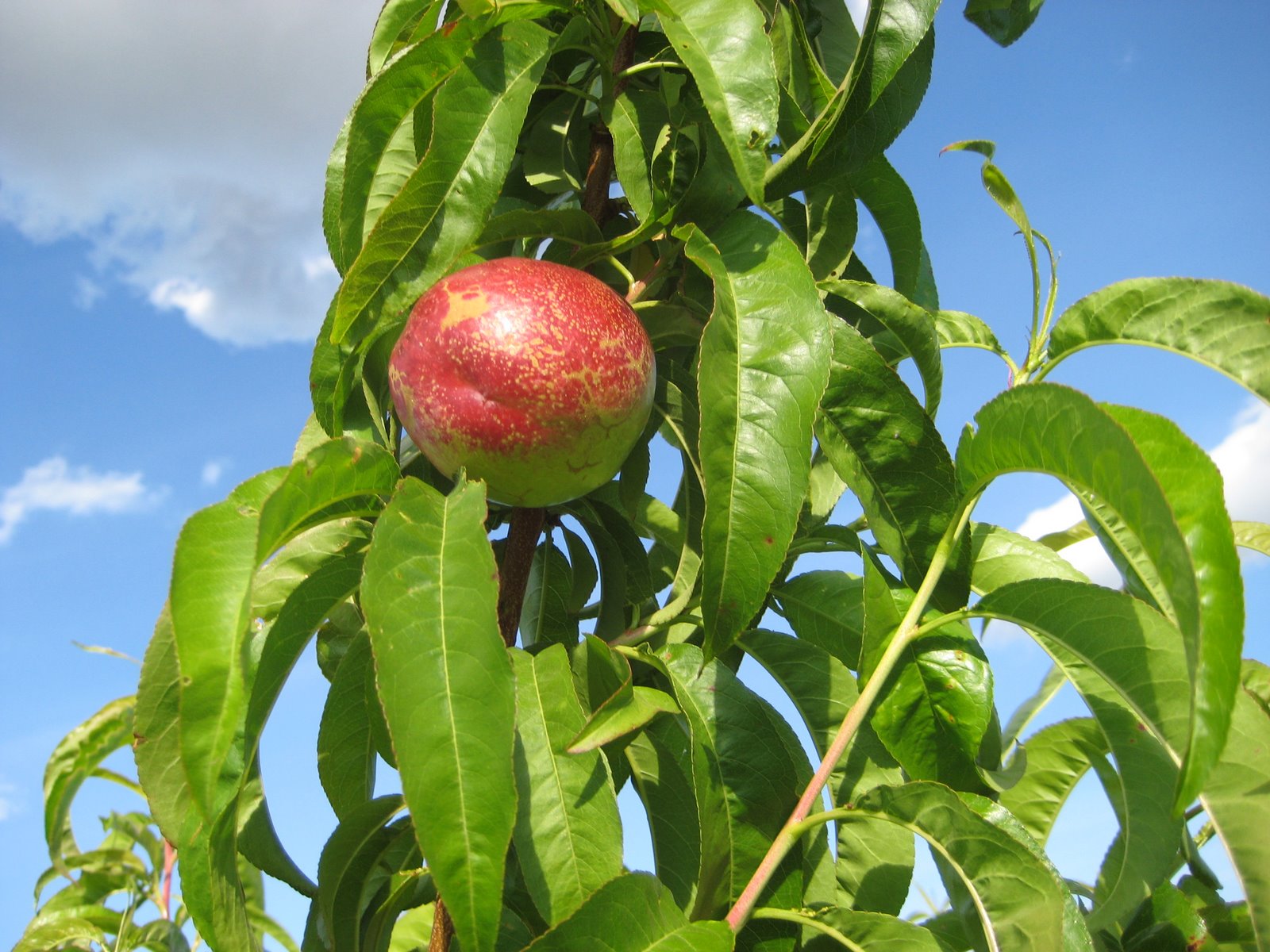

We now have nectarines in the fruit stand. We have independence and Flavorcrest varieties and hope to have a few other yellow and white varieties in the next few weeks.
Thursday, July 17, 2008
Tomatoes
Finally we have enough tomatoes so we don't have to limit the number we can let people buy at one time. We have lots more getting ready in the gardens, too.
Sunday, July 6, 2008
Peach Season is Here
We've been harvesting lots of ripe sweet peaches lately and have lots available in the fruit stand.
Right now for yellow peaches we have Flavorcrest, Red Haven and Regina varieties. Later this month we'll have Kim Elberta, Gene Elberta and Suncrest. We have Nectar white peaches for sale now and expect Babcock, Sugar Lady and Silver Logan in the next few weeks. Prices are $2-3.00 per pound.
Also in the fruit stand--
Plums-Santa Rosa (tree-ripened and very flavorful) and Satsuma-(red-fleshed)
Fresh Figs, Apricots, Grapefruit
Garden Vegetables-including summer squash, cucumbers, eggplant, string beans, Swiss chard & basil
Look at our harvest schedule on the orchard website for more details: http://www.otoworchard.com/calendar.html
Hazards of Farming--Smoky air from forest fires
Notice how the hills in the background to the south are barely visible because of the smoke. Today was also smoky enough to need to wear a respirator to work outside, but not quite as bad as when this photo was taken.
Saturday, July 5, 2008
Figs
Tuesday, June 24, 2008
Sunflower bouquet

If you are lucky, you will be able to see a bouquet of flowers that Helen has arranged at the farm stand. Currently we are showcasing sunflowers.
What's available this week: Flavorcrest peaches, Santa Rosa plums, Jade white nectarines, apricots, grapefruit, green and yellow squash, Swiss chard, French filet beans, Kentucky Wonder green beans, Armenian and Asian cucumbers, Lemon cucumbers, and honey from Newcastle.
Saturday, June 21, 2008
Summer Squash and Beans

Helen, Chris and Chrisy's gardens are all beginning to produce the crop for 2008. We have Black Beauty and Cocozella (striped) green zucchinis. The ever popular yellow Zucchini as well as Scallopini and crook neck squash have begun to make their appearance in the Fruit Stand. Yellow Wax Beans as well as Emerite, a French fillet bean are now producing. In about 10 days to two weeks I hope to be harvesting burpless cucumber, Asian eggplants, and Kentucky Wonder Beans.
On the topic of tomatoes. I predict tomatoes will show up in the fruit stand in about 3 to 4 weeks.
We hope you ha ve time to come by the orchard to see our gardens.
'
Monday, June 16, 2008
Santa Rosa plums

The appearance of Santa Rosa plums in the fruit stand is a sign that summer has officially arrived here on the farm. This plum is so popular it seems to have a fan club. It is fragrant with a distinctive sweet and sour flavor that thrills your palate.
The peach supply may be a little low this week since we have only a few Junecrest trees. Very soon we will be offering Jade a white nectarine, and Flavorcrest and Red Haven peaches,
We also have small Blenheim apricots, Red Beaut plums, grapefruit, hoshigaki, yellow and green zucchini, Swiss chard, beans, and basil.
Tuesday, June 10, 2008
Bee on Buckwheat
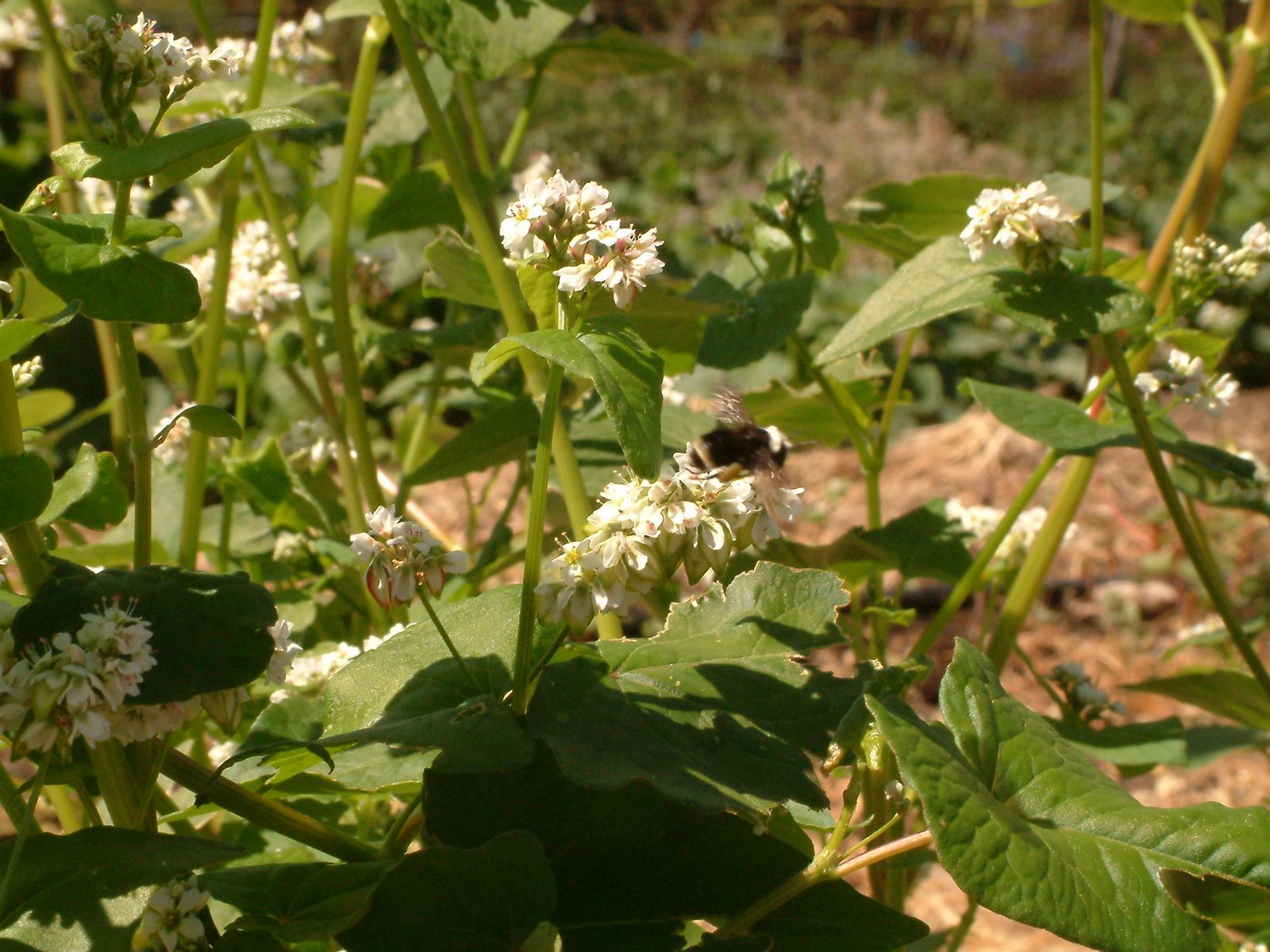
I couldn't get a good photo of bees on the borage plants, but here's a bee on some buckwheat flowers in the garden.
Borage & Winter Squash
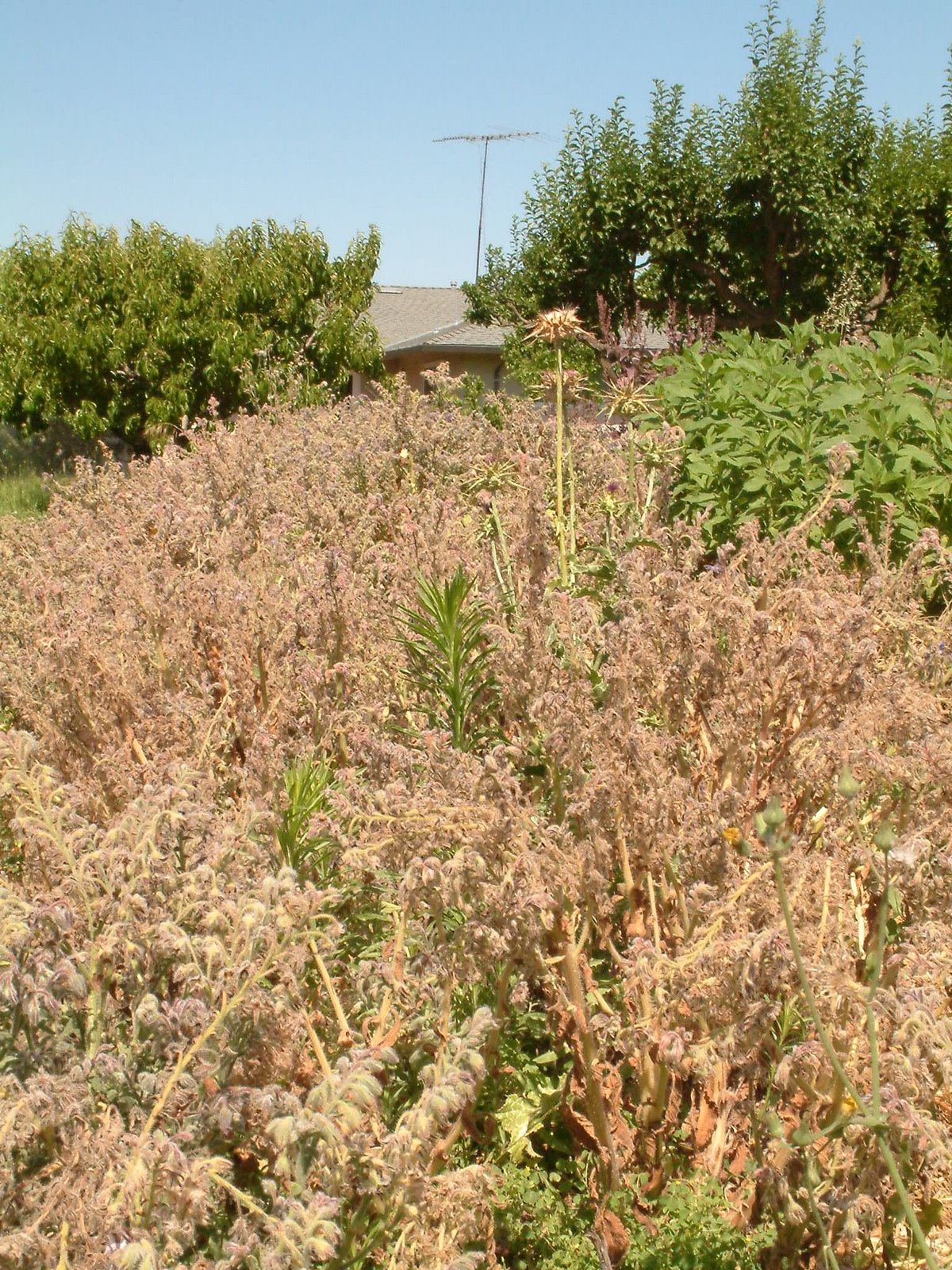
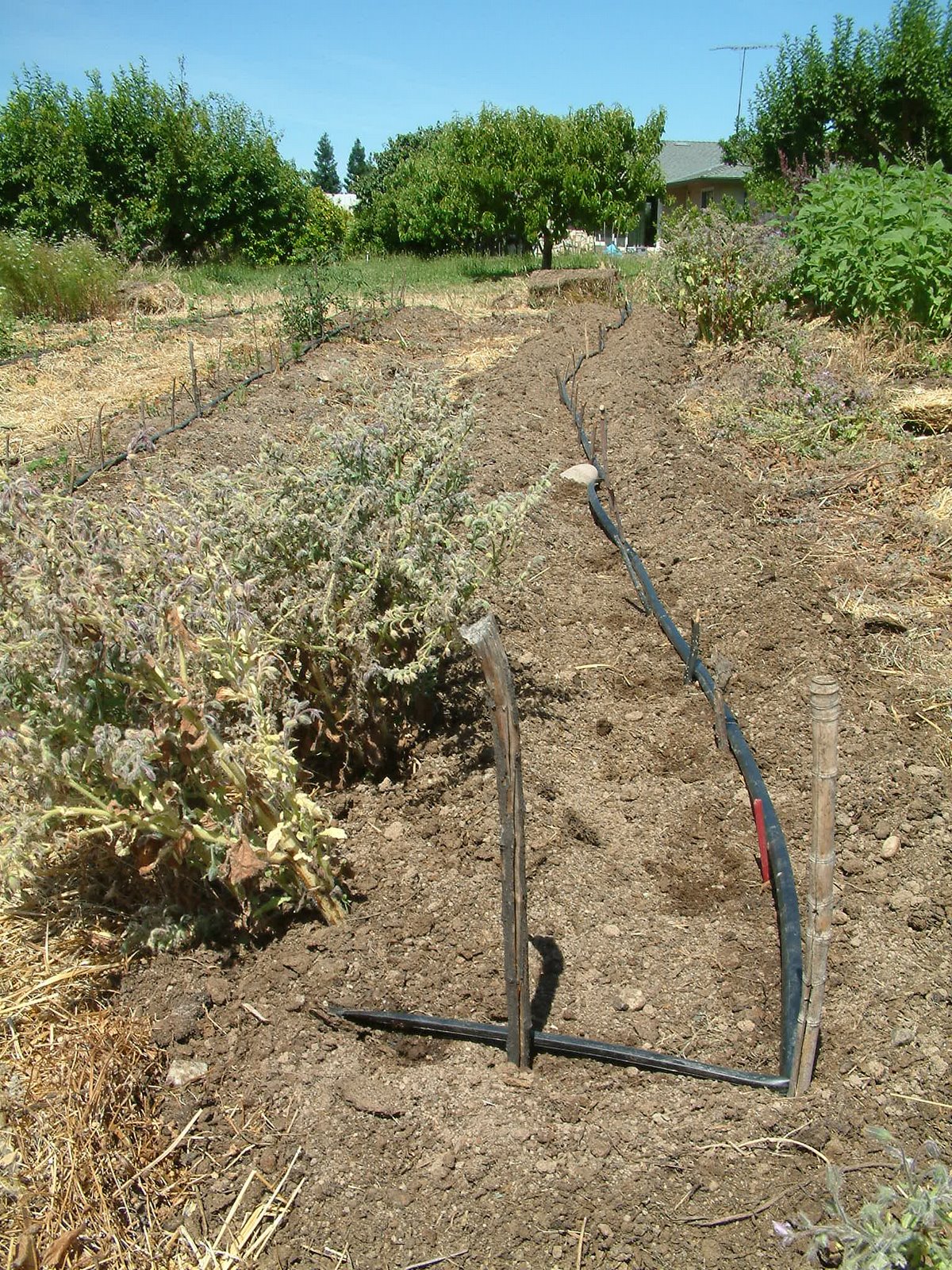
This weekend I had to pull out all the borage that had re-seeded itself and filled up a row in the garden. I felt bad having to pull most of it out, since the bees like to visit it so much, but I needed the space for winter squash. I left a few borage plants growing on the edges so the bees would still some have a few plants to be drawn to. The plants make good mulch in the paths, except that they're a little prickly. I hoed in compost and planted winter squash in the row. You can see the spots I planted marked with sticks.
Thursday, June 5, 2008
Peach Season Starting
 Right now the fruit stand has Spring Crest and May Crest peaches. They are both a yellow freestone peach, like many of our peaches. Our taste testing has yielded good reports. They are better than our early peaches usually are, but nothing measures up to our Faye Elbertas. Right now we are selling peaches from $2.00 to $2.50 per pound.
Right now the fruit stand has Spring Crest and May Crest peaches. They are both a yellow freestone peach, like many of our peaches. Our taste testing has yielded good reports. They are better than our early peaches usually are, but nothing measures up to our Faye Elbertas. Right now we are selling peaches from $2.00 to $2.50 per pound.
While supplies last, we will be selling our seconds (good for bakers who are not squeamish about "less than perfect" peaches) for $0.75 per pound.
Wednesday, June 4, 2008
Apricots

Robata is a large, round, orange apricot @$3.00 per pound. We have a short supply of Orange-Red a smaller and flavorful apricot at $3.50 per pound.
In the Fruit Stand: Apricots, plums, peaches, loquats, lemons, grapefruits, hoshigaki, calendula salve, basil, Swiss chard, and zucchini.
In the orchard: We invite customers to take a short walk into our forest of fruit trees and to visit Peas and Harmony's demonstration garden.





